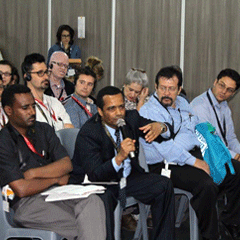Much ink has been devoted to the role large cities such as Mumbai, São Paulo and Cairo can play in a country’s economic growth. But not enough attention is being paid to the fastest growing urban areas of all, and the ones most likely to shape our urban future: secondary cities.
These cities, ranging in size from between 150,000 and five million, are becoming increasingly important for global development. Some 75 per cent of the world’s population lives urban settlements of less than 500,000 people. Despite their growing role, countries often ignore the productive role that secondary cities can play in a balanced national system of cities.
As a result, many secondary cities are facing numerous development challenges – including creating jobs, attracting investment for needed infrastructure, and diversifying or revitalising their economies – with far fewer options than their larger counterparts.
The problem will likely get worse as secondary cities, especially in African countries, are expected to double or even triple in population over the next 15 to 25 years. This means large infrastructure and service shortfalls, few opportunities for economic growth, and rising urban poverty.
A Global Study on Secondary Cities
In order to draw attention to the issue, the Cities Alliance made secondary cities the theme of our participation at the World Urban Forum, with the pre-launch of an important new global study on the issue and a high-profile networking event.
The timing is perfect. International development agencies are beginning to show an interest in supporting the development of secondary cities; however, there is little credible scholarship on the issue. To help close that knowledge gap, the Cities Alliance commissioned a global study on the systems of secondary cities in five regions and 16 countries, titled The System of Secondary Cities, which is expected to be published in September.
|
“Secondary Cities are asset rich and cash poor. How to better use these assets is a key for development.” --Dr. Brian Roberts, Author of The System of Secondary Cities |
Undertaken by Land Equity International Australia, the study examines the role secondary cities play in the development of global regions and nations, and how countries have approached urbanisation, decentralisation and other issues to support the development of a balanced system of cities.
The System of Secondary Cities will be formally launched in September 2014, but to mark WUF the Cities Alliance released a CIVIS knowledge product introducing some of the study’s key findings, and their potential benefits for economic development.
And they are startling. The study argues that with a more efficient system of secondary cities, many poor cities and rural regions could double or even triple their GDP. Small and medium-sized cities can facilitate the localised production, transportation, and transfer of goods and services throughout a country.
They can also enable other substantial economic benefits, including: industry agglomeration, localised supply chains and networks, a diverse economic and employment base, and a broad housing mix.
Sparking Discussion at WUF
|
These issues and others were the centre of a lively networking event at WUF on “Secondary Cities- Key links for equitable and sustainable city system,” organised by the Cities Alliance Secretariat in collaboration with the Inter-American Development Bank (IADB).
Chaired by Clare Short, former UK Secretary of State for International Development, the event attracted over 120 participants and featured panelists that included representatives from the National Planning Department Colombia, United Cities and Local Governments (UCLG) and the IADB.
Based on key inputs provided by Prof Brian Roberts from the University of Canberra, author of the The Systems of Secondary Cities, the discussion culminated in an agreement that the role of secondary cities is mostly overlooked in contemporary development approaches – a missed opportunity, because these cities can turn out to be crucial drivers of urbanising and thriving economies.
The discussion explored challenges that secondary cities are facing and some recommendations for how to address them. Key recommendations are:
- National policies can play an especially important role in supporting the development of secondary cities. Countries that implement urbanisation policies to improve the development of the national system of cities tend to be much more successful in managing urbanisation, city development, and ensuring equity between cities than countries that allocate a disproportionate amount of their public resources to the development of one or two large cities.
- Decentralisation helps as well; the more autonomy secondary cities have, the more competitive, dynamic, and self-sufficient they are likely to be.
- Economic competition between cities can help them learn how to be more competitive at the regional or global level. National governments can National governments can encourage competition between cities and assist them in enhancing their governance efficiency and business competitiveness.
Throughout the debate, participants highlighted that any focus on secondary cities should not exclude the role of primary cities or large metropolitan areas. Rather, it is important to focus on developing a balanced system that taps the potential of both primary and secondary cities.





